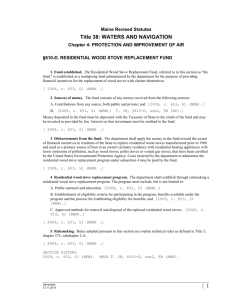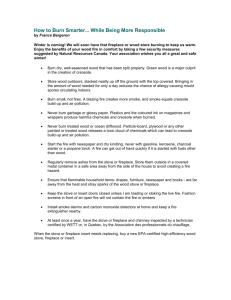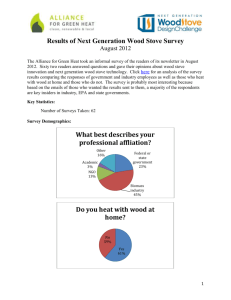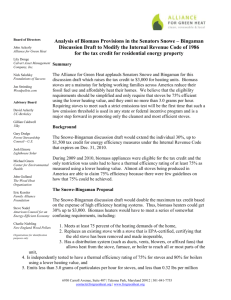Title Goes Here - The Masonry Heater Association
advertisement
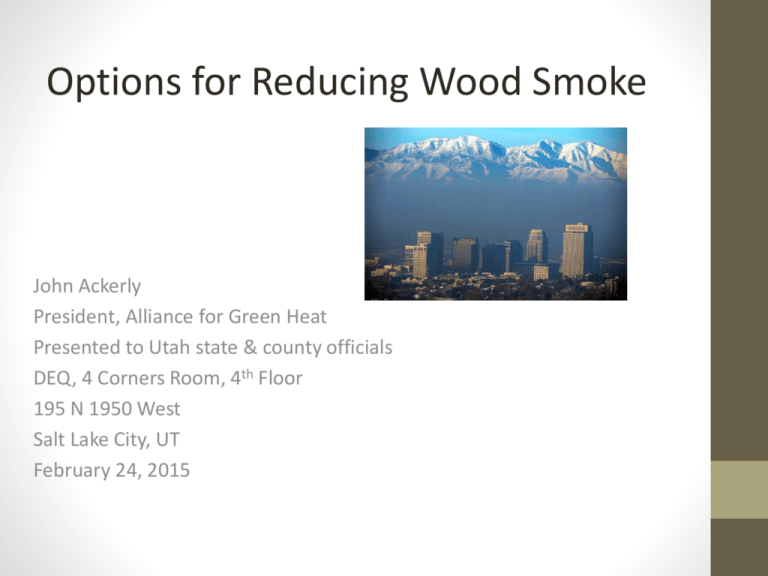
Options for Reducing Wood Smoke John Ackerly President, Alliance for Green Heat Presented to Utah state & county officials DEQ, 4 Corners Room, 4th Floor 195 N 1950 West Salt Lake City, UT February 24, 2015 Alliance for Green Heat 501c3 nonprofit funded by foundations & grants A national voice for wood heat consumers Work for more incentives for the cleanest & most efficient biomass heaters Call on government to provide R&D funding for ultra-clean “next generation” stoves Push for more transparency from manufacturers and EPA about testing and efficiencies. Integrate stoves into work of energy auditors and home energy professionals. Wood is 3rd most common heat in U.S. US Residential Heating Fuel Use 70 Millions of US Homes 60 50 40 Secondary 30 Primary 20 10 0 Electricity Natural Gas Wood Propane/LPG Fuel Oil Kerosene Wood Smoke in the US Income & wood heating Salt Lake County is ground zero 80% of all fireplaces and stoves in Utah are in the nonattainment area. Half of all fireplaces and stoves in non-attainment area are in Salt Lake county. Evolution of Stove Technology 1600s 1870 1744 1970s 1988 to present 1990 2012 2000 2013 Fall and Rise of Catalytic Stove EPA Testing: Lab vs. Real World • • • • EPA uses crib wood (2x4s, 4x4s) not cord wood EPA uses dry wood EPA starts test when stove is hot. Thus, the EPA does not capture emissions during start-up and reloading, the dirtiest part of the burn • Highly skilled technicians operate the stove for testing EPA Stove Testing • The test process is about $6,000 for pellet stoves and $10,000 and higher for wood stoves. • Stoves are tested at 4 burn rates – with air on lowest setting, medium low, medium high and highest setting. Those numbers are then averaged and average has to be under 4.5. • Lowest setting is almost always hardest. • Cordwood will probably be required in Next NSPS. Example of lab vs. real world emissions • Certified by EPA lab at 4 grams an hour • Consumer average may be around 6 – 12 g/hr Lab tests * Low burn: avg. of 8 gr/h • Medium low: 5 • Medium high 2.5 • High: 1 Real world could be • 15 gr/h low burn • 12 medium low • 10 medium high • 8 high 1 Wood stove = 10 pellet stoves • 1 wood stove can emit same PM as 10 pellet stoves. • Poorly operated EPA certified stove often emit same emissions as well operated uncertified stoves. • Most pellet stoves put out 1 – 2 grams an hour. • Pellet stoves rarely put out any visible smoke and can be vented like a dryer out side of house. • Pellet stove: Lab results are often similar to real world emissions, if stove is kept relatively clean. • Many EPA certified wood stoves average around 10 grams an hour, if they are operated relatively well. New EPA Regulations • Changes as of 2020: • Emission standards for stoves to drop from 4.5 to 2.0 in 2020 • In coming years, more stoves will be tested with cordwood • Prices should not change in next few years • Changes as of 2015/2016: • Pellet stoves will have to be certified • Exempt wood stoves will come off the market • Actual, verified efficiencies will start to be posted Options to reduce wood smoke Step 1 – less difficult & expensive • Education, education, education, education • Ban installation of uncertified stoves • Require permits & inspections to install stoves • Only allow pellet stoves under 1.5 g/hr to be installed & wood stoves under 2.5 or 3 gr/hr • Bounty or buy back program • Moratorium on the installation of fireplaces & wood stoves • Or, moratorium on installs where homes have gas access • Include stoves in energy audits & engage chimney sweeps Step 2 – more difficult & expensive • Sunset clauses in populated counties/areas • Change out: old wood to new gas or pellet only • Upon sale of home, dispose of old stoves • Cap & Trade Strategies • Engage more agencies and more experts • Building permit office • Energy auditors & chimney sweeps • Insurance companies • LIHEAP agencies Divide & Conquer * Target counties where most wood smoke originates • Target areas that have most access to natural gas • Rural, sparsely population areas without natural gas should not be targeted Education, education, education • Messaging: • Don’t waste your wood. Smoke is unburned wood with lots of BTUs in it. • Second hand smoke especially bad for your kids and elderly. • Themes: technology, fuel, operation • Benefits of pellet stoves (they can save you more money) • Benefits of dry wood (saves money; better for health) • Benefits of wood bricks (can save money; easier to store) Education: Insurance matters • Insurance companies may refuse to pay if stove was not permitted and/or inspected • Home owners should inform their insurance company. • Sometimes rates increase up to $40-$60 extra per year. • Some insurance companies see freestanding wood stoves as a greater risk than inserts. • Companies often want evidence stove was professionally installed or inspected. Education: stoves can be dangerous Wood stoves cause 4,000 house fires each year Over one-quarter of residential building heating fires result from improper maintenance of heating equipment, specifically the failure to clean the equipment. Agencies should strongly recommend sweeps certified by the Chimney Safety institute of America (CSIA) Chimneys should be cleaned annually by a certified sweep Require permits & inspections • Thousands of towns and counties and at least 4 states (MA, OR, WA & WI) require permits to install wood stoves • Permitted stove installations usually also requires inspection from a certified mechanical inspector. • Results in cleaner & safer installs • Prevents installs of uncertified stoves • In Utah, Manila and West Valley City require permits Ban install of old stoves • In non-attainment area, or in certain counties, only allow install of certified wood stoves and pellet stoves. • Still allows for healthy second hand trade in certified stoves (made since 1990). • Requires some enforcement & lots of education • Enables airsheds to preserve air quality gains and not backslide • Can require monitoring of craigslist and other second hand outlets. Ban install of outdoor & indoor boilers • In non-attainment area, or at very least in populated counties, even new, certified outdoor wood boilers pose a major air quality threat. • Indoor boilers won’t even be regulated until 2017 and should not be allowed to be installed between now and then. Only allow install of cleaner stoves • Only allow wood stoves under 2.5 or 3.0 g/hr • Only allow pellet stoves under 1.5 or 2.0 g/hr • Only allow EPA qualified fireplaces? • Many states have incentive & change out programs with stricter emission limits • Washington & Oregon have long done this. Buyback or Bounty Programs • Pay a “bounty” for people who turn in old wood stoves. • Bounty programs do not involve the purchase of a new stove or appliance. • Examples: • Allegany County, PA : • Sponsored by County Health Department in 2013 • $500 gift cards per old OWB • $200 gift card per old stove • Methow Valley, WA: • Sponsored by state DOE in 2012 • $250 per old wood stove • 69 stoves collected and destroyed Buyback logistics • Responsibility of homeowner to deliver stove • Need drop off site, ideally a steel recycler • Can give gift card or rebate check on spot • No questions asked; stove may not have been in use much, or at all. • $250 - $350 is far, far cheaper than change-out which often costs $700$1,000 & far more bureaucracy Moratorium on sales/installs • A 4 – 6 moratorium on wood stoves & fireplaces installs buys time to plan and educate people • A moratorium should not cover pellet stoves • Retailers can still sell gas, pellet and other equipment. • Timing is key. If moratorium covers entire fall & winter, it will be tougher sell. Include stoves in energy audits • Energy audits educate homeowners & lead to voluntary change outs • Auditors find many unsafe installs and often are working with homeowners ready to make efficiency improvements. • Building Professional Institute (BPI) now has stove inspection standards that Utah may be able to require for any subsidized audits Logistics: stoves in energy audits 1. Physical inspection of stove EPA certification Safety listing (UL, etc.) Structural integrity & rust Glass & gaskets Fire brick 2. Inspection of clearances 3. Inspection of evidence of smoke leakage 4. Inspection of fuel and fuel storage 5. Inspection of visible creosote on chimney LIHEAP designation of wood stoves as a “Health and Safety hazard”? LIHEAP funds can be used to replace wood stoves Not certified by the EPA? No UL listing? Cracked firebox? Insufficient clearances? Low income homes using an old stove as a primary heating unit may be eligible for assistance to get a new, clean, high efficiency stove Enforcing existing regulations • R156-55a-301. License Classifications - Scope of Practice. • (2) Licenses shall be issued in the following primary classifications and subclassifications: • S430 - Metal Firebox and Fuel Burning Stove Installer. Fabrication, construction, and installation of metal fireboxes, fireplaces, and wood or coal-burning stoves, including the installation of venting and exhaust systems, provided the individual performing the installation is RMGA certified. • http://www.rules.utah.gov/publicat/code/r156/r156-55a.htm Step 2 tactics • More resource intensive: $ and time • Potentially more intrusive • May work better at county level than in all of nonattainment area State tax credit: positive reinforcement • Offer a $500 - $750 state tax credit for pellet stoves under 1.5 or 2 grams/hr. • Drives sales toward pellet stoves • Highlights benefits of pellet stoves and helps educate people • Shows that the state supports selected wood heating appliances • Does not have to require trade in of old stove • Could limit it to rural households that do not have access to gas Sunset clause • Example: as of Jan. 1, 2018, no one can operate an uncertified wood stove. • Up to Dec. 31, 2017, old, uncertified wood stoves can be dropped off for $350 rebate; new pellet stoves eligible for $500 tax credit. • Vermont set sunset law for outdoor wood boilers, coupled with buyback or change-out funding. • Puget Sound Air Quality Agency is fining anyone with an uncertified stove after August 2015. Announced plan in 2012. http://www.airsafepiercecounty.org/wood-stoverule Change out program options • Likely has greatest acceptance by public and hearth industry as these are typically voluntary. • Rebates to swap out old wood stove for new gas or pellet stove. • Could offer new wood stove in rural areas without access to gas. • Scores of jurisdictions have done these with wide range of results. • Libby MT often cited as a success, but was very expensive and in a small, contained valley. Change out considerations • Should be coupled with laws banning installs of old stoves • Rebate gives leverage to require professional installation and stricter emission limits • Should be done in conjunction with buy back program • Can be done in conjunction with sunset clause • To minimize costs, option of buying value stoves from big box hardware stores can be emphasized Value Stove & Installation Costs Wood stove - Englander Wood stove Small: Medium: 1,200 1,500 sq. ft. 1,800 sq. ft. Large: 2,000 2,200 sq. ft. $550 $900 $650 Installation $500 , materials $500 Hearth pad $65 (Type II) $85 Installation $800 , labor $1,000 Total $1,915 $2,235 Pellet stove - Englander Medium : 1,500 1,800 sq. ft. Large: 2,000 2,200 sq. ft. Pellet stove $1,100 $1,550 $230 $230 $500 Installation Kit $45 $55 $85 Hearth pad (Type II) $700 $800 $1,000 Installation, labor Total $2,075 $2,635 $2,485 Libby MT Change out results Removal upon sale of home • Oregon requires that an uncertified stove be removed and destroyed upon sale of home. • Burden is on real estate brokers and homeowners. DAQ insert form # Utah Land Transfer Wood Stove Certification Instructions: 1. This form must be completed for all real property transfers located in Box Elder, Cache, Davis, Salt Lake, Tooele, Utah and Weber counties. 2. A completed form must be submitted to the following: Utah Division of Air Quality P.O. Box 144820 195 North 1950 West Salt Lake City, Utah 84114-4820 Part 1. Type of Land Transfer: __Residential ___Commercial ___Industrial Property address:_______________________________________________________________ Seller Name and Address:__________________________________________________ Phone Number:___________________ Buyer Name and Address:___________________________________________________ Phone Number:___________________ Is there a free standing *wood stove or a fireplace insert wood stove installed on the property? ___Yes ___No. If no, proceed to Part 2, Seller Certification – No Wood Stove. *A wood stove is defined as a solid fuel burning device other than a fireplace, including any fireplace insert, free standing wood stove, wood burning heater, coal stove, or similar device burning any solid fuel used for aesthetic or space-heating purposes. If yes, does the wood stove contain an EPA certification label on the back of the stove with an effective date of July 1, 1990 or later? ___Yes ____No. If yes, complete Part 3, Seller Certification – Wood Stove Meets EPA Certification. If no, complete Part 4, Certification of Destruction after the wood stove has been received by a recycler or scrap yard and rendered useless. Part 2. Seller Certification – No wood Stove I, ___________________, certify that I am the seller of said property and that the property does not contain a wood (print sellers name) stove. __________________________ (signature & date) Part 3. Seller Certification – Wood Stove Meets EPA Certification I, _________________, certify that I am the seller of said property and that the property contains a wood stove that is (print sellers name) EPA certified with an effective date of July 1, 1990 or later. __________________________ (signature & date) Part 4. Certification of Destruction I, ________________, ____________________________, hereby certify that I have received the following wood stove, (print individuals name) (name of recycler or scrap yard) _____________________________ , that this wood stove was presented to me by the seller of this property and that it (model name, type, serial number) has been rendered useless. ____________________________________ (signature & date) _____________________________ (seller signature & date) Requiring Destruction of Old Stove Upon Sale of Home • NH Bill Summary: All wood stoves made before 1986 and not EPA certified by shall be removed and destroyed upon the sale of a home if the home is in a densely populated area. • The seller who is responsible for the removal and destruction shall provide proof of destruction. • This NH bill did not pass • Exempt: • (a) Antique stoves: built before 1940 with ornate construction • (b) An indoor, wood-fired furnace that is thermostatically controlled, has a dedicated cold air inlet and connected to heating ductwork • (c) A masonry heater: site-built or site-assembled, solid fueled heating device constructed to store heat • http://www.gencourt.state.nh.us/legislation/2013/HB0307.html4 Cap & trade in Telluride, CO • In 1985, Telluride, Colorado required all wood burning stoves to be registered with the town. • Town set cap of 545 wood stove permits allowed to sold among residents. Market price for permits was $1,500 each in 1991 • Park City or Summit County considering this. Emission standards in 2015 EPA Residential Heater Regulations Technology Step 1: 2015-20 Step 2: 2020-23? 1988 - 2015 Wood stove – crib 4.5 2 7.5 Wood stove – cordwood 4.5 2.5 Pellet stove 4.5 2 Boilers 0.32 0.1 Warm air furnaces 0.93 0.15 Consumer Labels in New Rules • Stoves that test with cordwood in next 5 years, and can meet 4.5 grams an hour, can use a special EPA approved label to alert consumers that stove is designed and tested as it will be used by consumer. • Stoves that meet Step 2, 2020 emission limit of 2 grams an hour (or 2.5 with cordwood) can also use a special label alerting consumers that they meet strictest standards. • These are good steps but if EPA and Industry don’t make these work, a more comprehensive “green label” may be needed. Indoor air issues • Inversions especially make wood smoke a neighborhood public health • Smoke re-enters homes through any crack, or from forced air systems with outside air intake • Poor draft or negative pressure can cause fugitive indoor emissions • Old stove with cracks, old gaskets, etc. can leak • Any ongoing detectable smell of smoke needs addressing • $300 HEPA air filter can reduce indoor PM2.5 issues • With liquid fuels, danger is CO. With solid fuels its PM. Efficiency in New EPA Rules • Manufacturers have to start testing and publicly reporting efficiency using B415 & HHV. • Manufacturers have to disclose efficiency when stoves are tested for certification, or recertification. • Most stoves don’t have to be retested for years, so efficiency numbers likely to come out very slowly. • Manufacturers can voluntarily submit efficiency numbers at any time. (Industry is not encouraging this.) • The estimated default efficiencies (63, 72 and 78) will be phased out soon. • Efficiency measured by a “stack-loss” measurement Efficiency of wood appliances As tested at High Heating Value (HHV) 90% 80% 70% 60% Best Known 50% Default (EPA) 40% Average 30% Worst Known 20% 10% 0% Pellet Catalytic Non-catalytic Best heating fuel calculators The Alliance for Green Heat reviewed scores of the most popular fuel calculators and found many of them to be hard to use and biased. Of the dozens of calculators we reviewed, we recommend two: USDA Forest Service calculator Hearth.com calculator Our recommendations for heating fuel calculator efficiencies reflect values of a new appliance when it is being used with seasoned wood: • EPA certified non-cat stove: 70% • EPA certified cat stove: 75% • EPA certified pellet stove: 78% • Exempt/uncertified wood stove: 54% • Exempt pellet stove: 65% • EPA Phase 2 outdoor boiler: 65% • Exempt outdoor boiler: 45% • EN 303-5 pellet boiler: 80% Efficiency, draw and Dedicated outside air (DOA) • CFM in stoves range from 4 – 22. Avg. of 10-15 • The chimney is the engine of every stove wood stove (not with pellet stoves). • The Outdoor Air Myth Exposed - Woodheat.org • A high efficiency stove (80-83%) may have only 200 degree exhaust temp. • Most houses do not need DOA but more and more tight ones do. WA state requires DOA. What consumers need to know: Wood Stoves Efficiency: If efficiency is a real priority and the stove will be a primary heater, consider a catalytic stove. Catalytic stoves got a deserved bad rap in 80s and 90s but designs are far better today. Woodstock Soapstone, Blaze King and Travis make great catalytic stoves and report B415 efficiency numbers. They all make stoves that are over 80% HHV efficiency (90% LHV). Non-cats are 10 – 20% less efficient. Emissions: Key to low emissions is using dry, split wood, not the grams per hour as tested in the lab. Sizing is key: Make sure stove is sized to the space it can effectively heat. Professional installation: Find a pro certified by the National Fireplace Institute (NFI), http://nficertified.org. Wood stoves in BPI standards The Home Energy Auditing Standard (BPI-1100-T-2012): 7.8: Energy auditors shall Inspect solid fuel burning appliances for safe operation and efficiency. 7.23: Energy auditors shall recommend replacement of solid fuel burning appliances with listed and EPA-certified appliances if the existing appliance is not safety listed or has signs of structural failure. BPI Homeowner Questionnaire • 10. Do you have a working fireplace, woodstove or pellet stove • A. How often do you use it? • How often is the flue cleaned? • How often is the fireplace, woodstove or pellet stove cleaned? 11. What type of fuel is being used? • Where do you store the wood or pellets? • How much fuel did you use during the last heating season? • Are there issues such as excessive smoking or staining when the fireplaces, woodstove or pellet stove is in use? 12. Do you have the owners manual or installation guide for the appliance EPA certification and UL listing Make sure to check Back of stove for EPA and UL label. If brand and model are on EPA certified list. Year purchased. Before 1988, not certified. After 1988, probably certified. For glass door. If it has one, it’s likely certified. Note: Pellet stoves do not require EPA certification. Signs of structural failure Cracks and rust in the body Cracks in the door and glass Glass Dirty glass is a sign the stove owner is not operating stove correctly or the stove is inefficient. Recommend the homeowner clean the glass every day to see how quickly it gets dirty. If it gets dirty in a single day, the combustion is poor. Cracked glass should be replaced. Clearances from combustibles These are very general guidelines and do not reflect legal requirements. Inspect area for combustibles within 12 inches of stove (includes dry wall) Old, uncertified stoves usually require 18 – 24 inches from combustible. EPA certified stove usually require no less than 12 inches. Minimum clearances are printed in the stove manual. If manual cannot be found, follow NFPA guidelines. NFPA Recommended Clearances Radiant Stove Stove Pipe Ceiling 36” 18” Front 36” 18” Side 36” 18” Rear 36” 18” Floor 18” 18” Inspecting gaskets Missing or degraded gaskets could lead to smoke and CO entering the house. If the gasket around the stove door is loose, missing or degraded, recommend owner gets a replacement. Gasket rope comes in different sizes, so tell the homeowner to consult owner’s manual before buying. Smoke leakage Check the interior of the home for signs of smoke leakage, especially the fireplace and mantle in the case of wood stove inserts. A leaky stove is a health and safety hazard and should be replaced. Chimneys Chimneys collect creosote (tar), the leading cause of chimney fires, and should be inspected once a year. Check for creosote by looking up the chimney with a strong flashlight. Creosote can be visible on the grate of the chimney cap as well. BPI, Technical Standards for the Heating Professional says: “A deteriorated chimney must be repaired or relined and the cause corrected before reusing.” Smoke & carbon dioxide monitors Check if home has an operational smoke detector and carbon monoxide monitor and test them. Smoke alarms should be on a ceiling or high on a wall. Carbon monoxide alarms should also be placed at least 5 feet high, but not directly above or beside wood stoves, since they may emit a small amount of CO upon start-up. Firebrick Firebrick is essential to maintaining a hot fire. Hard to get hot enough combustion to certify a stove with EPA without firebrick. Cracks are OK, but once it crumbles or is removed for whatever reason by homeowner, it needs to be replaced. Many stove brands use same size firebrick but you have to measure it and make sure first. Firewood Inspect fuel storage to see if wood is split, stacked and covered. Splitting and stacking is essential; covering is best. Inspect wood to check if it is seasoned. Ideal is to test with moisture meter and show homeowner. Make sure you split wood and know how to use your meter. Seasoned wood is 20% or less moisture. Unseasoned wood leads to inefficient, smoky fires. Pressed wood bricks • Types: Blocks, bricks, and logs • Typical materials: sawdust, wood shavings, and wood chips • Typical cost per ton: $280-$300 • Typical size/weight (block): 2.5 x 4 x 6 in., 23 lbs. • Currently ~13 different brands and ~20 different products sold in the Northeast region Installation & repair certification National Fireplace Institute (NFI) Non-profit certification agency that trains, tests and certifies hearth professionals, mostly focusing on installation of new units. Chimney Safety Institute of America (CSIA) Focuses on chimneys but includes some hearth installation training. The Wood Stove Checklist Written by Alliance for Green with support from the University of Maryland Extension as a tool for home energy auditors and others to help assess wood stove safety and efficiency Available through the Extension website: http://www.naturalresources .umd.edu/Publications/FactS heets/FS936_2012_Wood_Stove_Che cklist.pdf Send any feedback to contact@forgreenheat.org Thank you! John Ackerly www.forgreenheat.org john@forgreenheat.org 301-841-7755


